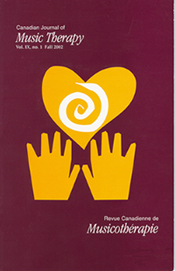Finding the Client in Their Environment: A Systems Approach to Music Therapy Programming
DOI:
https://doi.org/10.15845/voices.v4i2.183Resumen
Most extended care environments are fraught with noise pollution, resident distress, and staff busyness. The continual clamour of random sound events such as call bells, public paging systems, TVs, loud conversations, kitchen clatter and continuous foot traffic contribute to an alarming sense of frenetic activity and impervious indifference. The Emergent Voice is the sum of all sounds we hear. It is the qualitative and identifiable personification of health or illness in a system. An Emergent Voice that reveals disturbing sounds and disruptive behaviours can be influenced towards health through the experiencing of the aesthetic, temporal and structural properties of music. This perspective introduces an environmental approach to music therapy programming in institutional facilities and necessitates a basic understanding of systems and field theories, the physiology and phenomenology of sound, and a willingness to engage in, and listen to, the environment in a new way.
Descargas
Publicado
2004-07-01
Cómo citar
Woodward, A. M. (2004). Finding the Client in Their Environment: A Systems Approach to Music Therapy Programming. Voices: A World Forum for Music Therapy, 4(2). https://doi.org/10.15845/voices.v4i2.183
Número
Sección
International Archives
Licencia
Articles published prior to 2019 are subject to the following license, see: https://voices.no/index.php/voices/copyright

